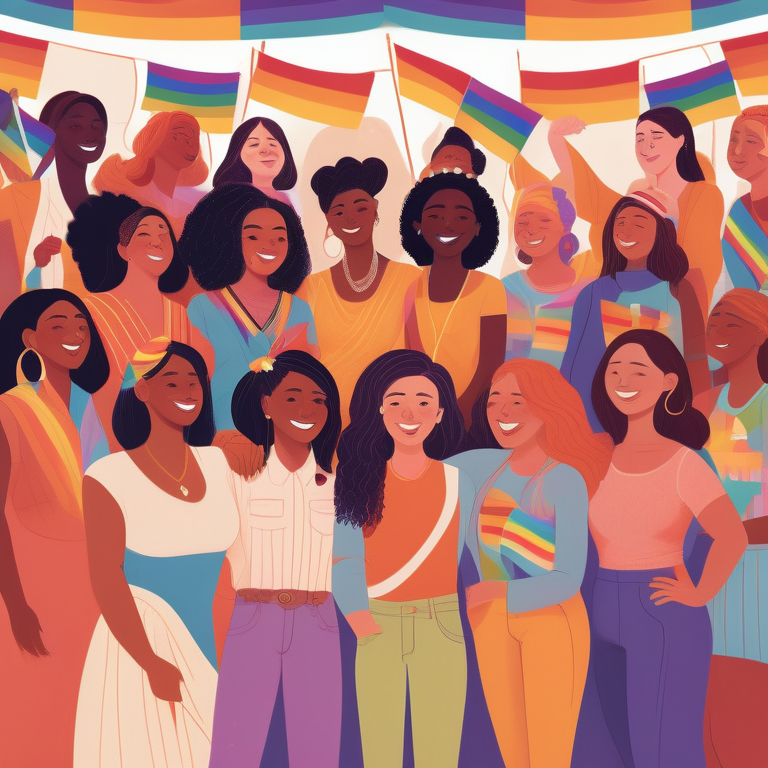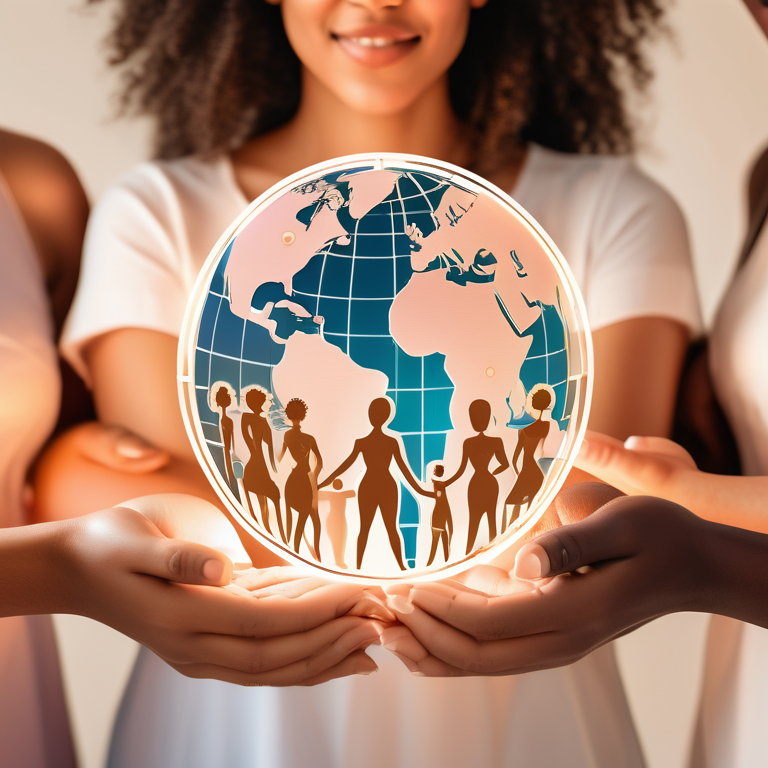Exploring LGBTQ+ Narratives and Female Sexuality

Key Highlights
- Women’s sexuality is diverse and varies between individuals, and it can change over time.
- Society’s understanding of female desire has evolved, acknowledging that women’s desire is not lower than men’s.
- Sexual orientation and gender identity play a significant role in understanding LGBTQ+ women’s sexuality.
- LGBTQ+ women face challenges of visibility and representation in media and literature.
- Female sexuality in LGBTQ+ narratives explores themes of sexual autonomy, consent, and the intersection of gender identity and sexual orientation.
- LGBTQ+ literature plays a crucial role in promoting empathy, understanding, and social change.
Introduction
Sexuality is a complex and multifaceted aspect of human existence, and it plays a crucial role in our lives. When it comes to understanding sexuality, it is essential to recognize the diversity and individuality that exists within different communities. In recent years, there has been a growing recognition and exploration of LGBTQ+ narratives and their impact on female sexuality, including experiences of sexual intercourse. These narratives have shed light on the experiences, challenges, and triumphs of LGBTQ+ women, providing a platform for their voices to be heard.
This blog will delve into the intricate world of LGBTQ+ narratives and female sexuality, exploring themes such as sexual desire, sexual orientation, gender identity, and the impact of cultural perceptions on LGBTQ+ women. We will also analyze the portrayal of LGBTQ+ women in literature and the role of LGBTQ+ literature in promoting social change. Through this exploration, we hope to foster greater understanding, empathy, and acceptance of diverse sexual orientations and experiences.
Understanding LGBTQ+ Women’s Sexuality
Understanding LGBTQ+ women’s sexuality requires a nuanced perspective that acknowledges the unique experiences and challenges they face. Just like heterosexual women, LGBTQ+ women experience sexual desire, explore their sexuality, and seek sexual satisfaction. However, the complexities of their sexual orientation and gender identity can impact how they navigate and express their desires.
Sexual desire, also known as libido, is a fundamental aspect of women’s sexuality, regardless of their sexual orientation. It encompasses the longing and attraction one feels towards others and plays a significant role in the formation of intimate relationships. Women’s sexuality is diverse and can vary between individuals. Some may experience higher levels of sexual desire, while others may have lower levels or may identify as asexual, experiencing little to no sexual attraction. Understanding the role of sexual arousal and sexual response in women’s sexuality, including those within the LGBTQ+ community, is crucial in promoting a more inclusive and comprehensive understanding of female sexuality.
Sexual orientation and gender identity are crucial factors in understanding LGBTQ+ women’s sexuality. Lesbians, bisexual women, transgender women, and queer women all have unique experiences shaped by their sexual orientation and gender identity. Lesbian women, for example, are attracted to other women and navigate their desires within the context of same-sex relationships. Bisexual women, on the other hand, experience attraction to both men and women, and their desires may fluctuate depending on individual preferences and circumstances. Additionally, studies conducted by Sean Massey and his colleagues at the Binghamton Human Sexualities Research Lab in New York have shed light on the complexities of sexual behaviors and orientations among LGBTQ+ individuals.
It is important to note that LGBTQ+ women’s sexual health needs and concerns may differ from those of heterosexual women. Regular sexual health screenings, access to LGBTQ+ inclusive healthcare providers, and knowledge about safe sex practices, including the use of condoms, are essential for LGBTQ+ women to maintain their sexual well-being and address any discomfort they may have. By understanding and addressing the specific needs of LGBTQ+ women, we can ensure that they receive the support and care they deserve for a fulfilling sex life.
The Evolution of Lesbian Identity in Literature
The evolution of lesbian identity in literature has undergone significant transformations over time. From early portrayals primarily focused on stereotypes and sensationalism to more nuanced and authentic representations, lesbian characters have become more complex and multidimensional in contemporary works. Authors such as Virginia Woolf and Audre Lorde have played pivotal roles in shaping the narrative around lesbian experiences, moving beyond caricatures towards realistic depictions that explore themes of love, desire, and relationships in depth. Through their writing, they have helped challenge societal norms and bring visibility to lesbian voices, contributing to a more inclusive and diverse literary landscape that reflects the rich tapestry of women’s sexuality.
Bisexual Representation and Visibility Challenges
Bisexual representation and visibility face significant challenges within the LGBTQ+ community. Often misconstrued as indecisive or promiscuous, bisexual individuals encounter stereotypes that invalidate their sexual orientation. Media portrayal frequently overlooks or misrepresents bisexuality, contributing to erasure and misunderstanding. The complexity of attraction to more than one gender is often simplified or sensationalized, further marginalizing bisexual experiences. Visibility within the community and broader society remains a struggle, with bisexual individuals navigating both acceptance and skepticism from various social circles. The need for accurate and inclusive representation is crucial to combatting misconceptions and promoting understanding of the diverse spectrum of sexual orientations. Bisexual voices deserve recognition and validation to foster a more inclusive and supportive environment.
The Impact of Cultural Perceptions on LGBTQ+ Women
Stereotypes and misrepresentations in media significantly affect LGBTQ+ women, shaping societal views and individual identities. Cultural norms often impose limiting beliefs, hindering sexual autonomy and expression. Breaking these barriers involves challenging conventional narratives through visibility and advocacy. Success stories of LGBTQ+ women demonstrate resilience against societal pressures, paving the way for more inclusive representations. Embracing diverse narratives is essential for dismantling harmful stereotypes and promoting acceptance. By fostering understanding and compassion, cultural perceptions can evolve to embrace the complexity and beauty of LGBTQ+ women’s experiences within the broader framework of sexuality and gender identity.
Stereotypes and Misrepresentations in Media
Stereotypes and misrepresentations of LGBTQ+ women in media perpetuate harmful narratives that influence societal perceptions. These depictions often reduce female sexuality to simplistic and hypersexualized portrayals, neglecting the diversity and complexity of women’s sexual experiences. From fetishization to erasure, media has played a significant role in reinforcing social norms and stigmas surrounding sexual orientation and gender identity. By sensationalizing and sensationalizing LGBTQ+ relationships and individuals, the media fails to capture the authenticity and emotional depth of these experiences, contributing to a lack of understanding and empathy among the general population. It is crucial to challenge these stereotypes and advocate for more accurate and inclusive representations to promote acceptance and diversity in mainstream media.
Breaking Barriers: Success Stories of LGBTQ+ Women
Navigating challenges, LGBTQ+ women have shattered stereotypes and blazed trails in various fields. Their resilience and achievements serve as beacons of inspiration. Take, for instance, the commendable journey of Sari Van Anders, Professor of Psychology, breaking new ground with her research on sexuality. In different times, LGBTQ+ women like her have triumphed, securing their place in academia and beyond. These success stories highlight not just individual accomplishments but also the collective triumph over societal norms. Celebrating victories of LGBTQ+ women in science, arts, and advocacy is crucial in fostering acceptance and appreciation for diverse narratives. Their breakthroughs contribute significantly to the broader landscape of gender studies and pave the way for continued progress and inclusivity.
Female Sexuality in LGBTQ+ Narratives
Exploring female sexuality within LGBTQ+ narratives delves into diverse expressions of sexual desire and orientation. These narratives often highlight unique challenges and experiences faced by LGBTQ+ women regarding sexual health and pleasure. Body image and sexual satisfaction are recurring themes in these stories, inviting readers to reflect on social norms and personal boundaries. Through the lens of gender studies, these narratives offer a sense of mystery and exploration, portraying a rich tapestry of sexual activities and intimate relationships. Authors like Sari Van Anders, a renowned professor of psychology, have paved the way for more nuanced representations of women’s sexuality in literature. By authentically portraying varied sexual expressions and identities, LGBTQ+ narratives contribute to a more inclusive understanding of female sexuality.
Exploring Sexual Autonomy and Freedom
In the realm of LGBTQ+ narratives, exploring sexual autonomy and freedom is paramount. This aspect delves into individuals’ rights to make choices regarding their sexual desires and preferences without external constraints. It embodies the essence of self-empowerment and liberation in navigating one’s sexuality authentically. Recognizing and respecting diverse expressions of sexual orientation and gender identity contributes to fostering a culture of inclusivity and acceptance. By embracing sexual autonomy, individuals can cultivate a sense of agency and independence in their intimate lives. This journey of self-discovery and empowerment plays a vital role in shaping healthy and fulfilling relationships within the LGBTQ+ community, fostering emotional well-being and genuine connections.
The Role of Consent and Communication
In LGBTQ+ narratives, the role of consent and communication holds immense significance. It fosters a sense of respect, trust, and empowerment within relationships, redefining traditional notions of sexual interactions. Understanding and affirming boundaries are foundational elements that promote healthy and fulfilling sexual encounters. Consent goes beyond a mere agreement; it involves active participation and ongoing communication to ensure all parties are comfortable and enthusiastic. Effective communication not only enhances intimacy but also allows individuals to express desires, boundaries, and preferences without fear of judgment. By prioritizing consent and open dialogue, LGBTQ+ women can navigate their sexual experiences with agency and mutual understanding, creating a safe and inclusive environment for exploration and pleasure.
The Intersection of Gender Identity and Sexual Orientation
Exploring the intersection of gender identity and sexual orientation provides a nuanced understanding of LGBTQ+ narratives. Individuals across the gender spectrum navigate diverse sexual orientations, including those who identify as intersex, impacting their experiences of sexual desire, pleasure, and intimate relationships. In gender studies, this intersectionality is crucial in unpacking societal norms and stereotypes that influence both women’s sexuality and LGBTQ+ communities. Examining how gender identity intersects with sexual orientation offers insights into the complexities of sexual expression and the fluidity of desire. This intersection challenges traditional binary frameworks, emphasizing the importance of recognizing and respecting diverse identities and experiences within LGBTQ+ narratives.
Understanding Transgender and Non-Binary Experiences
Transgender and non-binary experiences offer a rich tapestry of narratives within LGBTQ+ communities. Gender identity and sexual orientation intersect in complex ways, shaping individuals’ self-perception and interactions with the world. Understanding these experiences requires nuanced exploration of personal journeys and societal structures. Trans individuals may face unique challenges related to body image, sexual health, and societal norms. Non-binary individuals challenge traditional gender norms, emphasizing the fluidity of identity and expression. Sari van Anders, a Professor of Psychology, highlights the importance of acknowledging diverse gender identities beyond the binary. By embracing these diverse experiences, we can foster a more inclusive and understanding society that values all forms of gender expression.
Navigating Sexuality in a Gendered World
Navigating sexuality in a gendered world involves understanding how societal norms and expectations influence individuals’ sexual experiences. Women’s sexuality, often viewed through a male-centric lens, faces challenges rooted in traditional gender roles. From body image ideals to sexual expression, women encounter a range of expectations that can impact their sexual autonomy. In a world where gender binaries prevail, exploring sexual orientation beyond heteronormativity becomes essential for LGBTQ+ individuals. It’s crucial to recognize and challenge these norms, including the impact of movies and pornography on sexual pleasure, to create a more inclusive environment where diverse sexual orientations and gender identities are respected. By embracing the diversity of human sexual expression, we can foster a more accepting and understanding society for all.
Analyzing the Portrayal of LGBTQ+ Women in Literature
Analyzing the portrayal of LGBTQ+ women in literature delves into the diverse narratives that shape perceptions. These stories not only reflect societal attitudes but also challenge traditional norms. Authors like Sari Van Anders, a Professor of Psychology, have placed LGBTQ+ women’s experiences at the forefront, highlighting the intricacies of sexuality and identity. Through literature, these narratives confront stereotypes and contribute to a more inclusive literary landscape. By bringing LGBTQ+ characters to the forefront, these works create a sense of representation and validation for readers who may identify with these marginalized voices. The power of storytelling in literature extends beyond entertainment, serving as a platform for empowerment and social change.
From Marginalization to Mainstream Acceptance
In recent years, LGBTQ+ women have witnessed a shift from marginalization to mainstream acceptance in literature and media. Diverse voices and stories that were once silenced are now gaining visibility and recognition. This transformation highlights the evolving societal attitudes towards female sexuality and LGBTQ+ narratives. Through the portrayal of authentic experiences, these narratives challenge stereotypes and contribute to a more inclusive representation of gender and sexual orientation. This progress signifies a positive step towards creating a more empathetic and understanding society where LGBTQ+ women can feel validated and empowered in expressing their sexual identities and desires.
The Importance of Diverse Voices and Stories
Diverse voices and stories play a crucial role in highlighting the multifaceted nature of female sexuality within LGBTQ+ narratives. By showcasing a range of perspectives, experiences, and identities, these stories enrich our understanding of sexual orientation and gender identity. Through inclusive storytelling, individuals within the LGBTQ+ community can find validation, representation, and a sense of belonging. It fosters empathy, challenges stereotypes, and promotes acceptance in society. The intersectionality of race, ethnicity, age, and culture further amplifies the depth and complexity of these narratives, offering a more comprehensive portrayal of women’s sexuality beyond traditional norms and boundaries.
The Role of LGBTQ+ Literature in Social Change
LGBTQ+ literature plays a vital role in catalyzing social change by fostering empathy and understanding. Through diverse narratives and authentic voices, it challenges societal norms and biases, paving the way for greater acceptance and inclusion. By shedding light on the myriad experiences of LGBTQ+ individuals, literature humanizes their struggles and triumphs, dismantling stereotypes and prejudices along the way. Sari Van Anders, a respected professor of psychology, emphasizes the power of storytelling in reshaping cultural perceptions and advocating for equality. These stories not only educate but also inspire readers to question the status quo and advocate for a more equitable society. In essence, LGBTQ+ literature serves as a powerful tool for initiating meaningful conversations and driving positive societal transformations.
Literature as a Tool for Empathy and Understanding
Literature serves as a powerful tool for fostering empathy and understanding within society. Through diverse narratives and nuanced characters, it allows readers to step into the shoes of others, gaining insight into experiences different from their own. By delving into LGBTQ+ women’s stories, literature can challenge preconceived notions and promote acceptance. Authors have the ability to create authentic portrayals that resonate with readers, fostering a deeper sense of connection and empathy towards marginalized communities. Through storytelling, literature has the capacity to bridge gaps in understanding, sparking conversations and promoting inclusivity. The exploration of LGBTQ+ narratives in literature not only educates but also cultivates a more compassionate and empathetic society.
Challenging the Status Quo through Storytelling
Storytelling within LGBTQ+ narratives serves as a powerful tool for challenging societal norms and advocating for change. By portraying diverse experiences and perspectives, literature can confront stereotypes and misconceptions, fostering empathy and understanding. Through the art of storytelling, LGBTQ+ women can amplify their voices, shedding light on the struggles and triumphs within the community. Authors have the opportunity to reshape narratives, pushing boundaries and dismantling oppressive structures. By addressing social issues and advocating for inclusivity, LGBTQ+ literature paves the way for a more accepting society. Through narratives that challenge the status quo, storytelling becomes a catalyst for social change, empowering individuals to embrace their authentic selves.
Overcoming Challenges Faced by LGBTQ+ Women
Navigating the unique challenges encountered by LGBTQ+ women involves addressing issues such as mental health, social stigma, and discrimination. These women often face discrimination on multiple fronts, impacting their emotional well-being and sense of belonging. Social norms and stereotypes can exacerbate these struggles, leading to feelings of isolation and stigma. By promoting awareness and understanding, we can work towards creating a more inclusive society that values and respects the diversity of sexual orientations and gender identities. Providing support networks and access to resources tailored to the specific needs of LGBTQ+ women is crucial in fostering a community where everyone can thrive.
Mental Health and Emotional Well-being
Navigating the complexities of mental health and emotional well-being is crucial for LGBTQ+ women. The intersection of sexual orientation and gender identity can create unique challenges impacting their overall well-being. From societal stigma to discrimination, these individuals often face added pressure, leading to higher rates of mental health issues. Seeking support from mental health professionals who understand the specific needs of LGBTQ+ individuals is essential. Providing a safe space for these women to discuss their concerns without fear of judgment can greatly improve their quality of life. Taking care of one’s mental health is as important as physical well-being, and fostering a supportive community can make a significant difference in the lives of LGBTQ+ women.
The Impact of Social Stigma and Discrimination
Social stigma and discrimination have profound effects on LGBTQ+ women’s mental health and emotional well-being. These negative societal attitudes can lead to feelings of isolation, anxiety, and depression. The fear of rejection or judgment often prevents individuals from expressing their true selves or seeking support. Discrimination in healthcare settings can also result in inadequate access to sexual health resources and support for sexual expression. It is crucial to address and combat these harmful societal norms to create a more inclusive and accepting environment for LGBTQ+ women. By promoting understanding and challenging stereotypes, we can work towards a future where all individuals feel empowered to embrace their sexuality and identity without fear of discrimination.
Conclusion
Exploring LGBTQ+ narratives and female sexuality delves into the rich tapestry of experiences, challenges, and triumphs within the LGBTQ+ community. From literature’s transformative power to the struggles faced due to societal perceptions, this exploration highlights the importance of diverse voices and stories. By shedding light on sexual autonomy, consent, and the intersection of gender identity and sexual orientation, we pave the way for empathy, understanding, and social change. Through literature and storytelling, we challenge stereotypes, empower marginalized voices, and foster acceptance. Share these narratives on social media to amplify the voices that are reshaping our cultural landscape with inclusivity and authenticity.
Frequently Asked Questions
What is the importance of LGBTQ+ narratives in understanding female sexuality?
LGBTQ+ narratives play a crucial role in understanding female sexuality by challenging societal norms, providing diverse perspectives, and validating the experiences of LGBTQ+ women. They contribute to a more inclusive and comprehensive understanding of female sexuality beyond traditional heterosexual frameworks.
How can literature contribute to the acceptance of diverse sexual orientations?
Literature can contribute to the acceptance of diverse sexual orientations by providing authentic and diverse representations of LGBTQ+ individuals. By showcasing the complexities of diverse sexual orientations, literature challenges stereotypes, fosters understanding, and promotes acceptance and equality.
What are some recommended readings for exploring LGBTQ+ women’s sexuality?
Some recommended readings for exploring LGBTQ+ women’s sexuality include “Stone Butch Blues” by Leslie Feinberg, “Fun Home” by Alison Bechdel, “Oranges Are Not the Only Fruit” by Jeanette Winterson, and “Hood” by Emma Donoghue. These books provide diverse perspectives and insights into LGBTQ+ women’s experiences and desires.





